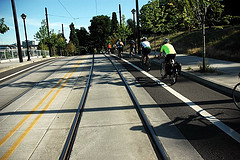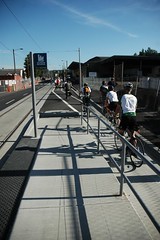The sixth installment of PDOT’s monthly Bicycle Master Plan Rides took a closer look at bikeway facilities in and around the central city.
A hearty group of cyclists followed the lead of City bike coordinator Roger Geller to the ride’s first stop: the South Waterfront. On our way, we sampled the handy wheelgutters that help cyclists get up the stairs between SW Market and Harrison.
Our destination on the South Waterfront was a newly designed streetcar platform. Looking to improve on the the platforms on NW Lovejoy St. (where cyclists must ride up on the sidewalk), the new design allows bicycles to flow through unimpeded to the right of the platform.
The design creates a bike-only channel that is buffered by curbs on both sides. This is expected to be a headache for maintenance crews (their sweepers won’t fit), so Geller expects PDOT will have to look into new, smaller sweepers if debris becomes an issue.
Heading back north, we rode the new bike lanes on Naito Parkway. I have previously shared my feelings about the gap in the bike lane under the Steel Bridge, so I made sure to ride this section with Geller to hear his take on the situation.
Geller says the reason the gap happened was because funding for the Naito project ended at NW Everett. He added that PDOT is working to fix the gap and that the problem exists only in the southbound direction, where PDOT engineers will work with the city’s freight committee to figure out a solution.
From Naito, we pedaled over the Broadway Bridge and made our way to below the Fremont Bridge via River Road. Geller pointed out the challenges in connecting the undeveloped “Cement Road” with Swan Island. It has the potential to provide a safe and direct alternative to N. Going Street (which is hilly and full of high-speed traffic), but the road is busy with freight trains and cement trucks.
The ride continued on to explore the Rose Quarter connection. Funding and alignment of a good route through this area — that will connect North Portland to the Esplanade — has remained an unanswered question for years.
Other stops and discussion included: how to cross from the Lloyd District to the Central Eastside Industrial District; debating the merits of SE 3rd Ave. as a way through the industrial area; and a look at how the Brooklyn neighborhood uses SE Clinton to connect to the Springwater Corridor Trail.
After the ride, participants joined Geller for mapping exercises and continued discussion at a local watering hole.
You can download a map of the route (with notes by Geller), on PDOT’s website. For more photos of the ride, check out my gallery.




